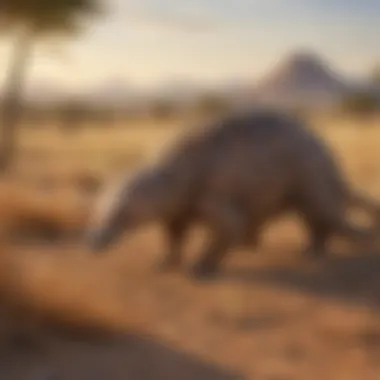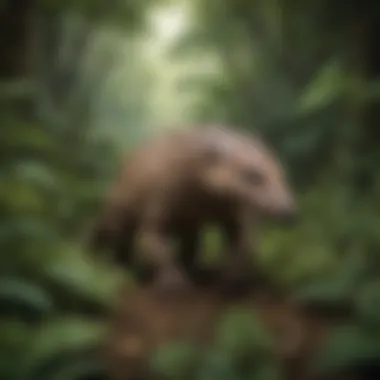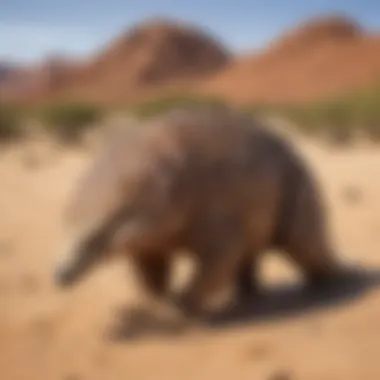Unraveling the Enigmatic Habitat of Pangolins: Where Do These Mysterious Creatures Reside?


The world of pangolins is enigmatic and fascinating, with their natural habitats and geographic distribution holding crucial importance. Pangolins, often referred to as scaly anteaters, are unique creatures that inhabit diverse environments across the globe. Understanding the ecosystems that support these elusive beings is essential for their conservation and protection. This article aims to delve deep into the mysterious habitats of pangolins, shedding light on their living conditions and the intricate balance of nature that sustains them.
Geographic Distribution
Pangolins are widely distributed across Asia and Africa, occupying a variety of habitats ranging from forests and savannas to grasslands and even urban areas. Each species of pangolin has its specific range within these regions, adapted to thrive in different environments. Their ability to adapt to various surroundings showcases their resilience and evolutionary uniqueness.
Forest Dwellers
Certain species of pangolins, such as the Sunda and Chinese pangolins, are primarily found in dense tropical forests. These lush habitats provide ample food sources like ants and termites, satisfying the pangolins' insectivorous dietary needs. The dense vegetation offers shelter and protection, allowing these creatures to blend seamlessly into their surroundings, avoiding predators and human disturbances.
Savanna Explorers
Other pangolin species, like the ground and tree pangolins of Africa, prefer the open savannas and grasslands. Here, they roam vast territories in search of ants and other insects, using their strong claws and keen sense of smell to locate prey efficiently. The savannas provide an expansive landscape for these creatures to forage and traverse, emphasizing their adaptability to a variety of ecosystems.
Human Impact
Despite their remarkable survival strategies, pangolins face numerous threats from human activities such as deforestation, poaching, and illegal wildlife trade. The destruction of their natural habitats and the demand for pangolin scales in traditional medicine have led to a drastic decline in pangolin populations worldwide. Understanding the delicate balance between human actions and wildlife conservation is crucial for the future coexistence of pangolins and other species.
Conclusion
Introduction
In this article, we embark on a captivating journey into the elusive world of pangolins, aiming to unveil the mysteries shrouding their natural habitats and geographic spread. By delving deep into the diverse environments these enigmatic creatures call home, we seek to provide readers with a comprehensive insight into the intricate ecosystems that support and sustain these fascinating beings. Pangolins, often referred to as scaly anteaters, captivate the imagination with their unique characteristics and behaviors, making them a subject of fascination and concern in the realm of wildlife conservation.


Defining Pangolins
Pangolins, intriguing creatures that straddle the line between reptiles and mammals, are distinguished by their scales covering their bodies, which they employ both as armor against predators and as tools for digging into ant and termite mounds—the primary components of their diet. Consisting of eight species spread across Asia and Africa, pangolins play a crucial role in maintaining the ecological balance of their habitats through their insectivorous nature and selective foraging habits. Despite their distinct physical appearance, pangolins remain largely misunderstood and vulnerable to extinction due to illegal poaching and habitat encroachment.
Significance of Understanding Pangolin Habitats
Understanding the habitats where pangolins thrive is paramount for their conservation and survival as a species. By gaining insight into the intricate relationships between pangolins and their environments, researchers and conservationists can develop targeted strategies to safeguard these unique creatures and the ecosystems they inhabit. Pangolins' habitat preferences also offer valuable information for identifying key areas for protection and restoration, ensuring the long-term viability of pangolin populations in the face of escalating threats and environmental changes.
Overview of Pangolin Species
Each of the eight pangolin species possesses distinct traits and adaptations that reflect their evolutionary history and geographic distribution. Asian pangolins, including the Indian, Chinese, and Sunda species, inhabit a range of forested habitats with specific ecological requirements tailored to their respective locations. In contrast, African pangolins, such as the tree and ground pangolins, have adapted to diverse environments spanning from dense rainforests to open savannas. Understanding the unique characteristics and distribution patterns of pangolin species is crucial for formulating targeted conservation strategies that address the specific needs and challenges facing each population.
Pangolin Habitats Across the Globe
In this section, we will delve into the indispensable topic of Pangolin Habitats Across the Globe. Understanding the diverse environments where pangolins inhabit is crucial in comprehending the intricate ecosystems that support these enigmatic creatures. Pangolins, often referred to as scaly anteaters, have distinct habitat preferences that vary across different regions of the world. By exploring the varied habitats of pangolins globally, we can gain valuable insight into their geographical distribution and the factors that influence their survival.
Asian Pangolins
Indian Pangolins
Chinese Pangolins
Sunda Pangolins
Ecosystems Supporting Pangolin Life


In this section of the article, we delve into the crucial role of ecosystems in supporting the life of pangolins. Pangolins, as unique creatures with specific habitat requirements, heavily rely on various ecosystems for their survival. Understanding the ecosystems that sustain pangolin populations is vital for conservation efforts and ensuring the continued existence of these enigmatic animals.
Tropical Forests
Tropical forests are one of the primary habitats for pangolins, providing ample food sources and shelter. These lush and biodiverse ecosystems offer a rich environment for pangolins to thrive, with an abundance of insects, termites, and ants - which form the bulk of their diet. The dense canopy and understory vegetation in tropical forests also offer crucial protection for pangolins from predators and other threats.
Pangolins are adept at maneuvering through the dense foliage of tropical forests, utilizing their strong claws to dig for food and create burrows for resting. These forests are characterized by high levels of humidity and rainfall, creating the ideal conditions for the insects that pangolins feed on. However, the rapid deforestation and degradation of tropical forests pose a significant threat to pangolins, leading to habitat loss and fragmentation.
Savannas and Grasslands
Savannas and grasslands also play a vital role in supporting pangolin life, particularly in African regions. These open habitats provide pangolins with ample opportunities to forage for ants and termites in the grassy plains. The scattered trees and shrubs in savannas offer pangolins refuge and nesting sites, contributing to their overall survival.
Pangolins found in savannas and grasslands have adapted to the more open landscapes, utilizing their keen sense of smell and strong claws to detect and dig for prey efficiently. The varied vegetation in these habitats supports a diverse insect population, ensuring a stable food source for pangolins year-round.
However, increased human activities such as agriculture, grazing, and infrastructure development have encroached upon savannas and grasslands, leading to habitat destruction for pangolins. Conservation efforts in these regions are essential to safeguard the remaining habitats for pangolins and mitigate the impacts of human encroachment.
Human Impact on Pangolin Habitats
Human activities have a profound impact on pangolin habitats worldwide, posing significant challenges to the survival of these species. Deforestation, illegal logging, poaching, and urbanization have extensively altered natural landscapes, leading to the degradation and fragmentation of pangolin habitats.
The conversion of forested areas into agricultural lands or urban centers directly infringes upon pangolin territories, displacing populations and disrupting their natural behaviors. Pollution and habitat degradation further exacerbate the challenges faced by pangolins, affecting the availability of prey species and overall ecosystem health.
As human populations continue to expand and exploit natural resources, the conservation of pangolin habitats becomes increasingly urgent. Effective management strategies, sustainable practices, and community involvement are paramount in mitigating the adverse effects of human impact on pangolin habitats and ensuring a harmonious coexistence between humans and these unique creatures.


Conservation Challenges and Efforts
In the realm of pangolin conservation, addressing the challenges posed to their habitats is crucial. These unique creatures face a myriad of threats due to factors such as habitat destruction, illegal wildlife trade, and human encroachment. Large-scale deforestation for agriculture, logging, and urban development has led to a significant reduction in suitable pangolin habitats, pushing these creatures towards the brink of extinction. Moreover, pangolins are highly sought after for their scales and meat, driving a thriving illegal trade that further decimates their populations.
Efforts towards conserving pangolin habitats involve a multi-faceted approach. Implementing and enforcing stringent laws to combat poaching and illegal wildlife trade is essential. Collaborating with local communities and raising awareness about the importance of pangolins in ecosystems plays a significant role. Wildlife reserves and protected areas are instrumental in providing safe havens for these creatures to thrive. Research initiatives to better understand pangolin behaviors and habitats aid in formulating effective conservation strategies. By engaging governments, conservation organizations, scientists, and local communities, concerted efforts can be made to protect pangolin habitats and ensure the survival of these enigmatic creatures.
Threats to Pangolin Habitats
Pangolin habitats face numerous threats that jeopardize the existence of these remarkable species. Habitat loss, primarily due to deforestation, agricultural expansion, and urbanization, poses a significant risk to pangolins. The destruction of forests not only limits the availability of food sources but also disrupts their nesting and breeding grounds. Additionally, pollution and climate change further exacerbate the challenges faced by pangolins, affecting the quality of their habitats and leading to detrimental impacts on their health and survival.
Initiatives for Habitat Protection
Various initiatives are being undertaken to safeguard pangolin habitats and mitigate the threats they face. Conservation organizations are working towards establishing protected areas and wildlife reserves that serve as sanctuaries for pangolins. These areas help prevent habitat destruction and provide secure environments for pangolins to thrive. Collaborative research projects on pangolin ecology and behavior contribute valuable insights into effective habitat protection measures. Implementing sustainable land management practices and promoting reforestation efforts are vital steps in restoring and preserving pangolin habitats for future generations.
Community Involvement in Conservation
Community engagement is a cornerstone of successful pangolin conservation efforts. Local communities play a key role in protecting pangolin habitats through participatory conservation initiatives. By involving communities residing near pangolin habitats in conservation projects, a sense of ownership and responsibility towards safeguarding these ecosystems is fostered. Educating communities about the importance of pangolins in maintaining ecological balance and offering alternative livelihood options helps reduce dependencies on activities that harm pangolin habitats. Empowering communities to actively participate in conservation efforts not only benefits pangolins but also promotes sustainable coexistence between humans and wildlife.
Conclusion
In the journey through the realm of pangolins and their habitats, the Conclusion section serves as a pivotal moment of reflection and synthesis. It encapsulates the essence of understanding pangolin habitats and their importance in the broader context of conservation and biodiversity. By appreciating the interplay between these enigmatic creatures and their diverse environments, we gain a profound insight into the delicate balance of ecosystems.
Emphasizing the need for concerted efforts in safeguarding pangolin habitats becomes paramount as we unravel the intricate connections between these creatures and their surroundings. The significance of preserving these habitats extends beyond the conservation of a single species; it embraces the preservation of entire ecosystems and the myriad life forms they support. Through this exploration, we come to realize the intrinsic value of every habitat and the intricate web of life that sustains our planet.
Appreciating the Diversity of Pangolin Habitats
Delving deeper into the tapestry of Pangolin Habitats, we uncover a rich tapestry of varied landscapes and ecosystems that these elusive creatures call home. From the verdant jungles of Asia to the vast savannas of Africa, each habitat harbors its own unique secrets and challenges, shaping the lives of pangolins in distinct ways.
Asian Pangolins find refuge amidst dense forests, where they navigate lush undergrowth and towering canopies to find sustenance and shelter. Meanwhile, African Pangolins traverse the open plains and wooded areas, adapting to the diverse terrains they inhabit. The Habitat Characteristics section unveils the intricate details of these environments, highlighting the crucial role each ecosystem plays in supporting pangolin life.
As we immerse ourselves in the diversity of pangolin habitats, we gain a deeper appreciation for the complexity of nature's design and the resilience of these incredible creatures. Each habitat represents a thread in the intricate tapestry of life, underscoring the interconnectedness of all living beings on our planet. Through understanding and respecting the diversity of pangolin habitats, we embark on a journey of discovery and conservation, committed to safeguarding these precious environments for future generations.















